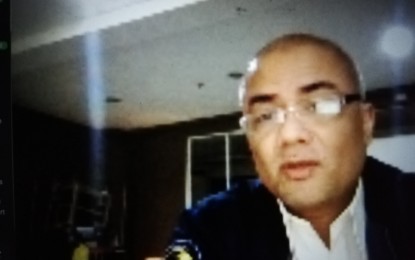
SPACE EDUCATION. Philippine Space Agency director Joel Marciano Jr. says he is looking for “T-shaped” people as the agency is currently developing its manpower. Marciano also wants more students to learn about space education. (Photo taken during the 2nd Integrated STEM Leadership Summit in Asia virtual event on Jan. 21, 2021)
MANILA – The Philippine Space Agency (PhilSA) is looking to hire more people and bring space education to high school students, its chief said Thursday afternoon.
In a webinar, PhilSA director Joel Marciano Jr. said since the agency is new, it is currently developing its manpower and that he is looking for “T-shaped” people or those that have the expertise.
"We are developing a T-shaped workforce. We are hiring more people. Right now, you may not feel us yet," he said, adding that PhilSA was established in 2019 and mobilized in 2020.
"The PhilSA aims to contribute to the international community through scientific enterprise," Marciano said.
The agency is also currently developing its space education and public outreach division.
Marciano said PhilSA targets to educate high school students about cube satellites and nanotechnology to integrate space education in science, technology, engineering, mathematics (STEM) studies.
PhilSA recently announced the start of building a next-generation satellite under the Advanced Satellite for the Philippines (ASP) project of the STAMINA4Space Program.
The project is funded by the Department of Science and Technology (DOST) and implemented by the University of the Philippines (UP) and the DOST-Advanced Science and Technology Institute (ASTI), in coordination with PhilSA.
They have partnered with Surrey Space Technology Ltd (SSTL) for the design and manufacture of a multispectral satellite capable of imaging an approximate area of 100,000 km2 of the country daily.
"SSTL is a leader in developing commercial-grade earth observation satellites as well as delivering a Know-How Transfer and Training (KHTT) program that can aid in our capacity-building efforts," DOST Secretary Fortunato de la Peña said in a message.
He said phase 1 of the project started in December through the remote delivery of the Satellite System Design course by the University of Surrey. This was attended by 30 Filipino engineers.
Another set of courses and lectures on systems engineering will be delivered by the SSTL this month to further equip engineers with the theoretical knowledge needed to build the country's next satellite.
Thirteen of the 30 engineers will be deployed to SSTL in the UK for full immersion in the design and manufacture of the Philippines' next satellite, de la Peña said.
"Phase 1 will mainly focus on mission definition and satellite design, which will take into consideration the requirements of various stakeholders. The Phase 2 activity will be transitioned to and led by the PhilSA to continue on the building and launching of the satellite, as well as retaining and utilizing the know-how gained through this collaboration to essentially improve our local satellite development capabilities, both in turnout time and reliability," he added.
He said the commercial-grade satellite with SSTL will provide timely, high-resolution images of the Philippines, from which insights can be made to aid decision-making in agriculture, disaster management, national security, and coastal monitoring and ocean studies.
The expected launch year of the satellite is 2023. (PNA)
In a webinar, PhilSA director Joel Marciano Jr. said since the agency is new, it is currently developing its manpower and that he is looking for “T-shaped” people or those that have the expertise.
"We are developing a T-shaped workforce. We are hiring more people. Right now, you may not feel us yet," he said, adding that PhilSA was established in 2019 and mobilized in 2020.
"The PhilSA aims to contribute to the international community through scientific enterprise," Marciano said.
The agency is also currently developing its space education and public outreach division.
Marciano said PhilSA targets to educate high school students about cube satellites and nanotechnology to integrate space education in science, technology, engineering, mathematics (STEM) studies.
PhilSA recently announced the start of building a next-generation satellite under the Advanced Satellite for the Philippines (ASP) project of the STAMINA4Space Program.
The project is funded by the Department of Science and Technology (DOST) and implemented by the University of the Philippines (UP) and the DOST-Advanced Science and Technology Institute (ASTI), in coordination with PhilSA.
They have partnered with Surrey Space Technology Ltd (SSTL) for the design and manufacture of a multispectral satellite capable of imaging an approximate area of 100,000 km2 of the country daily.
"SSTL is a leader in developing commercial-grade earth observation satellites as well as delivering a Know-How Transfer and Training (KHTT) program that can aid in our capacity-building efforts," DOST Secretary Fortunato de la Peña said in a message.
He said phase 1 of the project started in December through the remote delivery of the Satellite System Design course by the University of Surrey. This was attended by 30 Filipino engineers.
Another set of courses and lectures on systems engineering will be delivered by the SSTL this month to further equip engineers with the theoretical knowledge needed to build the country's next satellite.
Thirteen of the 30 engineers will be deployed to SSTL in the UK for full immersion in the design and manufacture of the Philippines' next satellite, de la Peña said.
"Phase 1 will mainly focus on mission definition and satellite design, which will take into consideration the requirements of various stakeholders. The Phase 2 activity will be transitioned to and led by the PhilSA to continue on the building and launching of the satellite, as well as retaining and utilizing the know-how gained through this collaboration to essentially improve our local satellite development capabilities, both in turnout time and reliability," he added.
He said the commercial-grade satellite with SSTL will provide timely, high-resolution images of the Philippines, from which insights can be made to aid decision-making in agriculture, disaster management, national security, and coastal monitoring and ocean studies.
The expected launch year of the satellite is 2023. (PNA)
